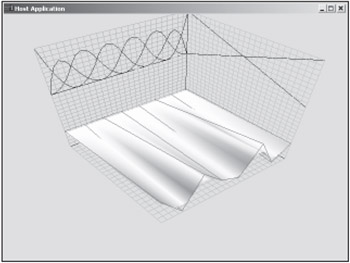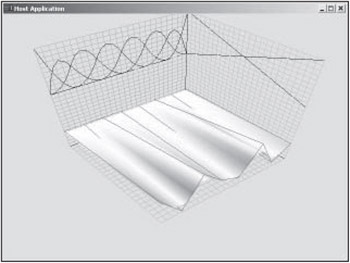In Conclusion
| | | ||||||||||||||||||||||||||
| ||||
| | ||||
Ruled Surfaces
Ruled surfaces are very straightforward and do not require many changes to the sheets that you've seen in previous chapters. The idea is that you have a set of two or more shape curves in one parametric direction and you linearly interpolate between them in the other parametric direction. This is one of the basic tools that product, automobile, and ship designers use. If you know a set of profile shapes that roughly define a larger shape, you can use a ruled surface to interpolate between the profiles. From Chapter 3, "Parametric Equations and Bezier Curves," you know that you could describe a ruled surface between two curves with the following equation.
| (10.1) Equation for a basic ruled surface. | |
One example of a ruled surface is shown in Figure 10.1. The surface in the screenshot is similar to a hanging curtain. One edge is straight and the other edge is a wavy shape. Each point between the two edges is linearly interpolated from those two shapes.

Figure 10.1: A simple ruled surface.
Take a look at the basis functions in the preceding figure. The shape curves have a higher order in the u direction, but the curve in the v direction is simply a second-order (linear) function. You could increase the number of shape curves by increasing the number of points in the v direction but staying with a second-order function. This is shown in Figure 10.2.

Figure 10.2: A ruled surface with three shape curves.
As you can see, you can implement ruled surfaces in the same basic NURBS framework used in Chapter 9. There are cases where this might not be true. For instance, the basic NURBS code does not include the ability to have two shape curves with different knot vectors. In that case, you would need to add more code, but the implementation would still be very straightforward.
Even if you keep the underlying framework as is, you might still want to provide a more intuitive interface to ruled surfaces. My framework treats NURBS surfaces as a grid of control points. A more intuitive way of setting the control points might be to provide a function that accepts an array of profile curves. At a lower level, these profiles could be mapped to points in the grid.
| | ||||
| ||||
| | ||||
EAN: 2147483647
Pages: 104